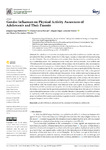Gender Influences on Physical Activity Awareness of Adolescents and Their Parents

Use este enlace para citar
http://hdl.handle.net/2183/28360
A non ser que se indique outra cousa, a licenza do ítem descríbese como Atribución 4.0 Internacional (CC BY 4.0)
Coleccións
- Investigación (CCDEF) [297]
Metadatos
Mostrar o rexistro completo do ítemTítulo
Gender Influences on Physical Activity Awareness of Adolescents and Their ParentsAutor(es)
Data
2021-05-26Cita bibliográfica
Lago-Ballesteros, J.; García-Pascual, M.; González-Valeiro, M.Á.; Fernández-Villarino, M.Á. Gender Influences on Physical Activity Awareness of Adolescents and Their Parents. Int. J. Environ. Res. Public Health 2021, 18, 5707. https://doi.org/10.3390/ijerph18115707
Resumo
[Abstract] The imbalances between the actual physical activity (PA) of adolescents and the subjective perception both they and their parents have in this regard can play an important role in perpetuating inactive lifestyles. The aim of this study is to analyse these discrepancies by considering gender as a conditioning factor. The participants in the study were 1697 adolescents, 1244 mothers and 1052 fathers in the educational communities of 26 secondary schools located in urban environments of the Autonomous Community of Galicia (Spain). With regard to actual physical activity, a high prevalence of sedentarism (82.1%) was revealed, this being even more acute in girls (87.8%). However, the perceived levels of activity differed significantly from the actual ones with a clear general overestimation both by the adolescents and their parents. When further exploring the data, gender influences were also detected both in adolescent and parental perceptions, since the high rates of overestimation in sedentary individuals were lower in girls and, on the contrary, the low rates of underestimation in active individuals were higher in girls. Moreover, although the level of agreement between actual and perceived physical activity was low overall, with Cohen’s kappa values ranging from 0.006 to 0.047, the lowest values were observed in the case of girls. In conclusion, both the adolescents and their parents were incapable of correctly assessing the actual physical activity of the former, so it seems that the general population lacks knowledge about the amount of physical activity that adolescents need to do to achieve a healthy lifestyle. Consequently, it would be advisable to implement health education campaigns and awareness-raising interventions directed to young people as well as to their parents and, in doing so, gender must be considered by establishing distinct program designs in terms of this variable.
Palabras chave
Gender differences
Physical activity
Assessment imbalances
Adolescents
Diferenzas de xénero
Actividade física
Desequilibrios de avaliación
Adolescentes
Physical activity
Assessment imbalances
Adolescents
Diferenzas de xénero
Actividade física
Desequilibrios de avaliación
Adolescentes
Versión do editor
Dereitos
Atribución 4.0 Internacional (CC BY 4.0)
ISSN
1660-4601






